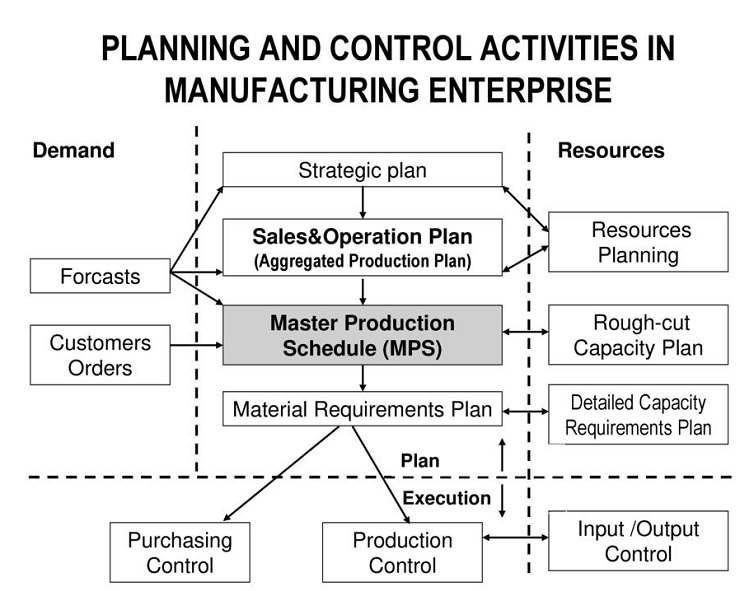Logistics and enterprise information systems Sample Assignment
MASTER SCHEDULE
The master schedule is a plan in which the manufacturing output is followed and matched against the orders that have been placed by the customers. Master scheduling regulates when the specific product groups will be formed after the placement of customer’s orders and the amount of manufacturing capability that is still accessible for fresh customer orders.
Vector experiences two types of demands that should be considered in the development of the master production schedule, that are independent demand and dependent demand (Pedersen and Slepniov, 2016). The independent demand includes valves orders that it receives from customers and the dependent demands are sub-assembly and other products that are required to make the values. Input data that is required for Vector are quantity and time of production of various parts that are required for the production of finished valves. Second is a bill of material and third is current inventory status. Accurate and reliable data from these three sources will help to improve the master production schedule for Vector.
Development of accurate master schedule is very significant for Vector as it will help in developing the link between what is produced in the manufacturing unit and what needs to be produced at that specific time in the manufacturing unit. Another benefit is the calculation of inventory and material that is required for production (Cleve, 2017). In addition to this, it will also help to eliminate the noteworthy issue of Vector that is late delivery.

Figure 1 The Master Production Schedule
Source: Nebl, 2018
The approach for developing the master production schedule for Vector mainly depends upon the balance between demand and resources (Nebl, 2018). The demands for production schedule can be estimated based upon forecast and current customer orders, in this process selection of appropriate forecasting method is important for high accuracy. The resources are managed based upon resource planning, capacity planning and detailed requirements planning. The process of development of production schedule for vector starts with creating a strategic plan which is taken as a reference for the sales and operation plan. In this process, all the factors for demand and resources are also considered (Cleve, 2017). This helps to develop the master production schedule. Based upon the master production schedule material requirement plan is made which help to decide goals for purchasing and production control.
Demand time fence is critical for Vector for development of Master schedule. In this method, a fence is set between the current date and demand time (Hitomi, 2017). The main benefit of this method is that production is stable and orders in between the fence are delivered in time but the limitation of this process is that urgent demand can unstable the production. The next method that can be used in Vector which is likely to be most beneficial is Make to order strategy. In this process, the master schedule is developed and managed based upon real-time orders and does not depend much upon forecast.
RECOMMENDATIONS TO IMPROVE MASTER SCHEDULE AT VECTOR
It is recommended that vector must use an ERP- Enterprise resource planning software to ensure proper development of master schedule and demand planning. This will help to get real-time data as it can be observed that data sheets are updated within five days in Vector and also eliminate errors. In addition to this to overcome the challenge of twelve hours of production capacity, the company can outsource some production (Cousins et al. 2019). Third proper training must be given to all the workforce regarding planning and operation to remove errors. Demand planning can also be managed effectively with the help of customer relationship management software.
REFERENCE
- Athanasopoulos, G., Hyndman, R.J., Kourentzes, N. and Petropoulos, F., 2017. Forecasting with temporal hierarchies. European Journal of Operational Research, 262(1), pp.60-74.
- Brocklebank, J.C., Dickey, D.A. and Choi, B., 2018. SAS for forecasting time series. SAS institute.
- Chase, C., 2019. How Does Consumption-Based Forecasting Improve Business Results?. Journal of Business Forecasting, 38(3).
- Chen, X., Hu, P., Shum, S. and Zhang, Y., 2016. Dynamic stochastic inventory management with reference price effects. Operations Research, 64(6), pp.1529-1536.
- Cleve, B., 2017. Film Production Management: How to Budget, Organize and Successfully Shoot Your Film. Taylor & Francis.
- Cousins, P.D., Lawson, B., Petersen, K.J. and Fugate, B., 2019. Investigating green supply chain management practices and performance. International Journal of Operations & Production Management.
- Hitomi, K., 2017. Manufacturing systems engineering: a unified approach to manufacturing technology, production management and industrial economics. Routledge.
- Hyndman, R.J. and Athanasopoulos, G., 2018. Forecasting: principles and practice. OTexts.
- Luftman, J., Lyytinen, K. and Zvi, T.B., 2017. Enhancing the measurement of information technology (IT) business alignment and its influence on company performance. Journal of Information Technology, 32(1), pp.26-46.
- Mithas, S. and Rust, R.T., 2016. How information technology strategy and investments influence firm performance: Conjecture and empirical evidence. Mis Quarterly, 40(1), pp.223-245.
- Muller, M., 2019. Essentials of inventory management. HarperCollins Leadership.
- Nagle, A., Fisher, S., Frazier, S. and McComb, S., 2018. Streamlining a Simulation Center's Inventory Management. Clinical Simulation in Nursing, 18, pp.1-5.
- Nebl, T., 2018. Production Management. Produktionswirtschaft. Walter de Gruyter GmbH & Co KG.
- Pedersen, P.C. and Slepniov, D., 2016. Management of the learning curve: a case of overseas production capacity expansion. International Journal of Operations & Production Management.
- Pham, T., Pham, D.K. and Pham, A., 2018. From Business Strategy to Information Technology Roadmap: a practical guide for executives and board members. Taylor & Francis.
- Singh, D. and Verma, A., 2018. Inventory management in the supply chain. Materials Today: Proceedings, 5(2), pp.3867-3872.
- Taylor, S.J. and Letham, B., 2018. Forecasting at scale. The American Statistician, 72(1), pp.37-45.
- Wild, T., 2017. Best practice in inventory management. Routledge.


